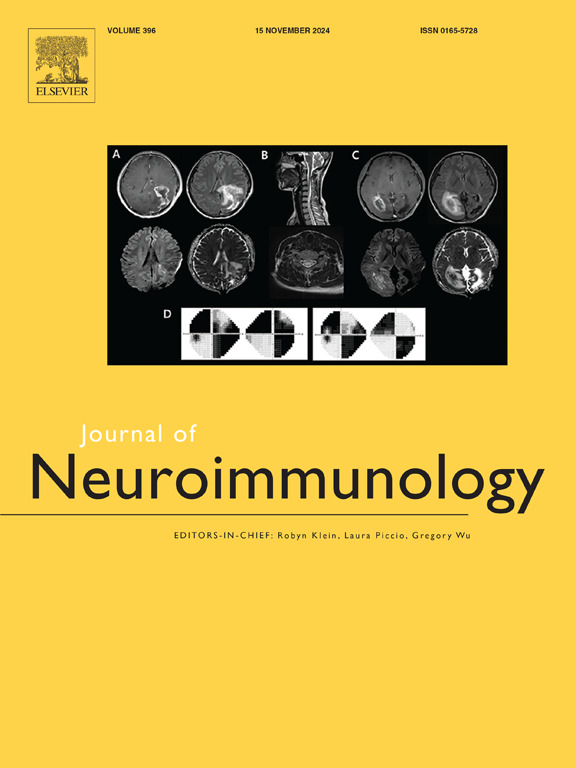神经元特异性PTEN基因敲除小鼠齿状回的胶质变化与细胞增殖的变化相关
IF 2.5
4区 医学
Q3 IMMUNOLOGY
引用次数: 0
摘要
海马神经发生失调是颞叶癫痫(TLE)的一个特征,其特征是神经元增殖增加。肿瘤抑制基因磷酸酶和紧张素同源物(PTEN)调节神经元增殖,其缺失与TLE有关。我们之前已经证明,在小鼠中缺失神经元亚群特异性(NS)-PTEN会增加整个齿状回的增殖细胞数量,包括通常缺乏神经元但富含胶质细胞的亚区,最明显的是门窝和分子层。在这项研究中,我们假设NS-PTEN基因敲除小鼠在这些相同的齿状回亚区会表现出增加的小胶质细胞和星形胶质细胞数量。我们在野生型和NS-PTEN基因敲除小鼠4周龄和10周龄时对Iba1(小胶质细胞)和GFAP(反应性星形胶质细胞)进行免疫组化。我们的数据显示,NS-PTEN基因敲除小鼠在两个年龄阶段都表现出增加的Iba1+细胞密度,并具有一些雄性特异性效应。齿状回分区域分析显示,在4周时,NS-PTEN基因敲除小鼠的颗粒细胞层(GCL)和门部的Iba1+细胞密度增加,在10周时,GCL、门部和分子层的Iba1+细胞密度增加。此外,我们观察到具有变形虫形态的小胶质细胞数量增加,而具有细分枝突起的小胶质细胞数量减少。与Iba1+小胶质细胞相比,GFAP+反应性星形胶质细胞定位于神经源性GCL。重要的是,正如我们之前的研究所报道的,这两种胶质细胞类型的增加与细胞增殖(Ki67+细胞)的增加密切相关,强调了神经胶质细胞在NS-PTEN基因敲除小鼠神经发生的空间失调中的作用。本文章由计算机程序翻译,如有差异,请以英文原文为准。

Glial changes in the dentate gyrus of neuronal-specific PTEN knockout mice correlate with changes in cell proliferation
Dysregulated hippocampal neurogenesis is a feature of temporal lobe epilepsy (TLE), marked by increased neuronal proliferation. The tumor suppressor gene phosphatase and tensin homolog (PTEN) regulates neuronal proliferation, and its deletion is implicated in TLE. We have previously shown that deletion of neuronal subset-specific (NS)-PTEN in mice increases the number of proliferating cells throughout the dentate gyrus, including subregions that are typically devoid of neurons but rich in glial cells, most notably the Hilus and Molecular Layer. In this study, we hypothesized that NS-PTEN knockout mice would exhibit increased numbers of microglia and astrocytes in these same dentate gyrus subregions. We performed immunohistochemistry for Iba1 (microglia) and GFAP (reactive astrocytes) on wild-type and NS-PTEN knockout mice at 4 and 10 weeks of age. Our data reveal that NS-PTEN knockout mice exhibit increased Iba1+ cell density at both ages, with some male-specific effects. Subregional analysis of the dentate gyrus showed that at 4 weeks, NS-PTEN knockout mice had greater Iba1+ cell density in the Granule Cell Layer (GCL) and Hilus, and at 10 weeks, increases were observed in the GCL, Hilus, and Molecular Layer. Additionally, we observed an increased number of microglia with an amoeboid morphology and fewer with thin, ramified processes. Contrast to Iba1+ microglia, GFAP+ reactive astrocytes were localized to the neurogenic GCL. Importantly, increases in both glial types strongly correlated with heightened cell proliferation (Ki67+ cells), as reported in our previous study, underscoring the role of glial cells in the spatial dysregulation of neurogenesis in NS-PTEN knockout mice.
求助全文
通过发布文献求助,成功后即可免费获取论文全文。
去求助
来源期刊

Journal of neuroimmunology
医学-免疫学
CiteScore
6.10
自引率
3.00%
发文量
154
审稿时长
37 days
期刊介绍:
The Journal of Neuroimmunology affords a forum for the publication of works applying immunologic methodology to the furtherance of the neurological sciences. Studies on all branches of the neurosciences, particularly fundamental and applied neurobiology, neurology, neuropathology, neurochemistry, neurovirology, neuroendocrinology, neuromuscular research, neuropharmacology and psychology, which involve either immunologic methodology (e.g. immunocytochemistry) or fundamental immunology (e.g. antibody and lymphocyte assays), are considered for publication.
 求助内容:
求助内容: 应助结果提醒方式:
应助结果提醒方式:


